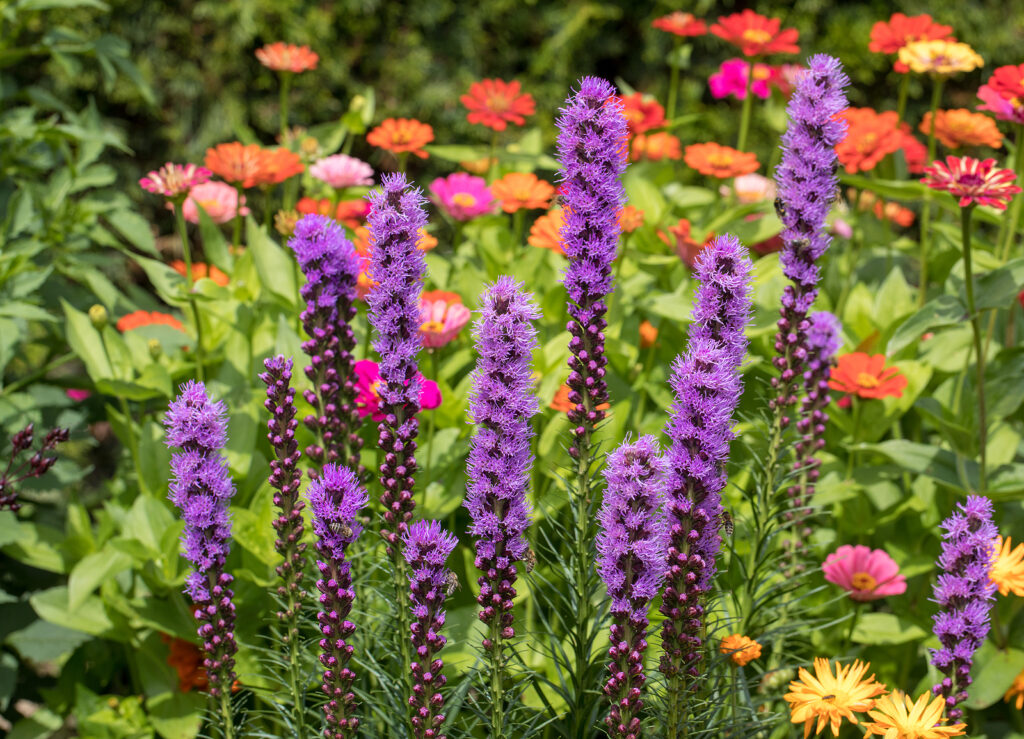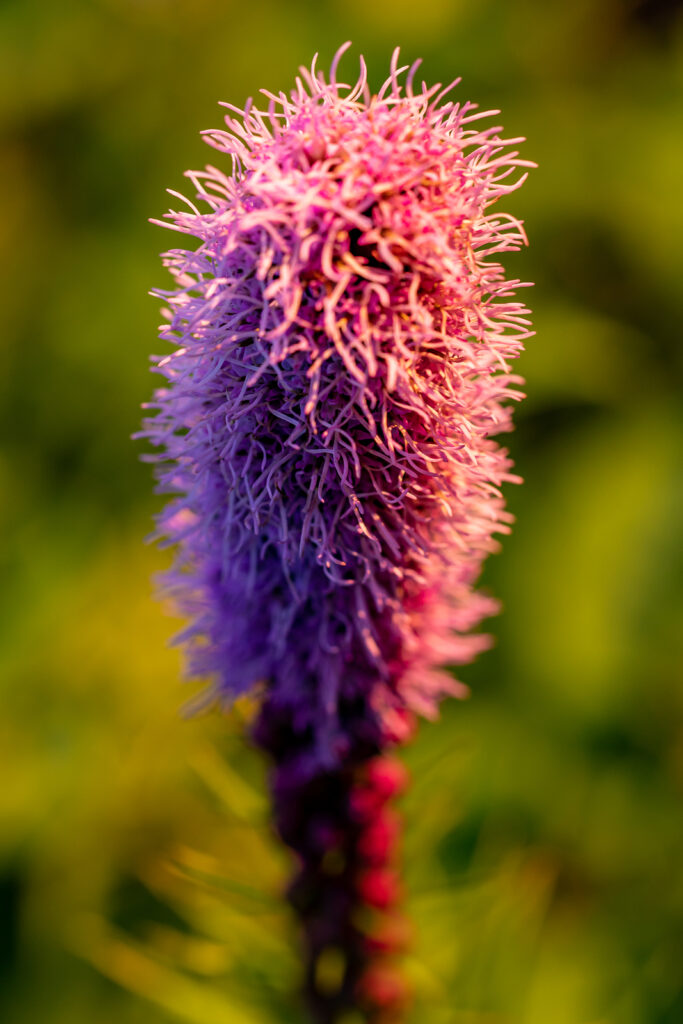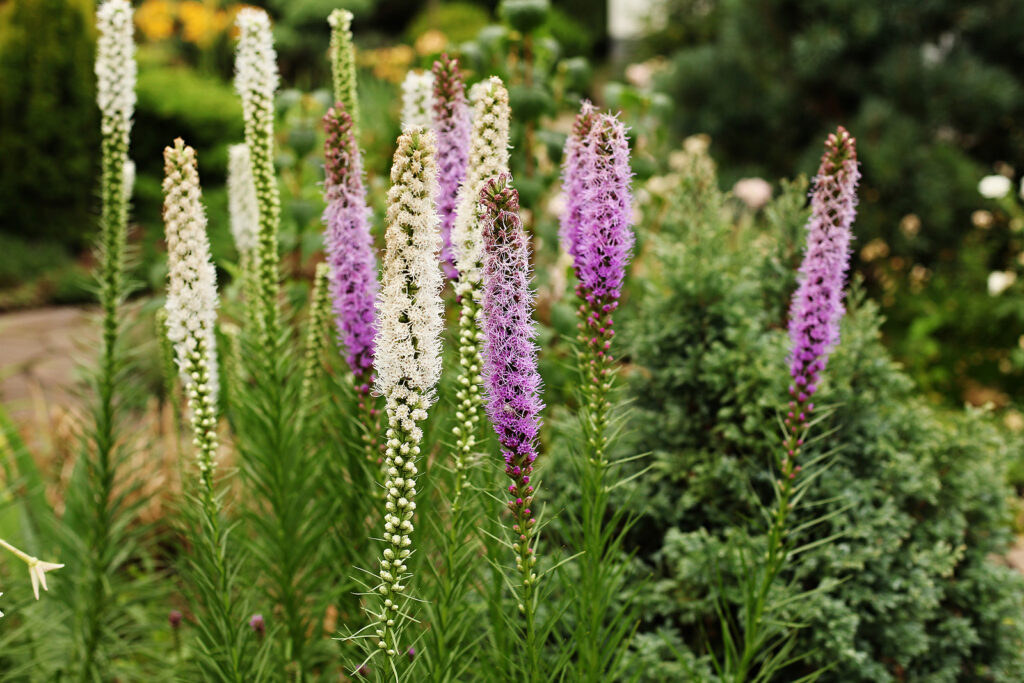Liatris–commonly called blazing star–is an upright, cold- and salt-tolerant perennial with clumps of linear leaves. From late summer to early fall, poker-like spikes of fluffy, pinky-purple, or white flowers appear.
Liatris is a genus of showy North American perennial plants of the Composite family. The small flower heads are generally borne close against the long wand-like stems.
Liatris is attractive throughout midsummer and well into autumn. they are effective when massed in flower beds. The flowers are usually purple, but white forms are also known.
They are raised easily from seed or by division of the clumps, but they can resent transplanting.

Get to know Liatris
- Plant type: Perennial
- Growing Zones and range: Zones 3-9
- Hardiness: Hardy to -35°F (-37°C)
- Height and width: 18 to 36 inches (45-91cm) tall; 8 to 24 inches (20-61cm) wide, depending on the variety
- Foliage: Linear to ovate-lance-shaped leaves are borne in basal tufts
- Flowers: Button-like flowerheads in corymb-like spikes or racemes composed of dense clusters of tubular flowers
- Flower colors: Bright pink, purple, or white flowers
- Bloom time: Midsummer
- Uses: Plant in masses, meadow garden, butterfly garden
- Common name: Blazing Star, gayfeather
- Botanical name: Liatris spp.
- Family: Asteraceaea
- Origin: Europe and North America
Where to plant Liatris
- Grow Liatris in full sun.
- Plant Liatris in average to sandy soil.
Liatris uses and companions
- Use Liatris in a mixed or herbaceous border.
- Use Liatris in formal borders and naturalistic plantings.
- Liatris attracts bees and butterflies.
- Good companions for Liatris include Achillea, Chrysanthemum superbum, Coreopsis, Echinacea, Gypsophila paniculata, and ornamental grasses.

When to plant Liatris
- Set outdoors Liatris in the garden in spring or fall.
- Sow seeds in autumn for blooming plants the following summer.
Planting and spacing Liatris
- Space Liatris 8 to 24 inches (20-61cm) apart. Plant in mass for the best effect.
- Sow seed in evenly prepared soil or indoors in light potting soil.
How to water and feed Liatris
- Liatris needs moderate water; keep the soil just moist.
- Fertilize Liatris every 6 weeks with an all-purpose fertilizer or work a slow-release fertilizer into the soil in early spring.
Liatris care
Mulch around Liatris to conserve soil moisture.
- Stake Liatris as needed to keep them from flopping. Crowding plants help them support one another.
- Trim spent blooms to encourage new blooms.
- Divide Liatris every 4 years or so as needed.
- Liatris is commonly free of pests and diseases.
Liatris pests and diseases
- Liatris is susceptible to stem rot, rust, and leaf spot diseases.
- Slugs and snails will attack Liatris.

Liatris propagation
- Liatris seeds germinate in 15 to 20 days at 55° to 72° (13°-22°C).
- Sow seeds in containers in a cold frame in autumn.
- Divide Liatris in spring.
Liatris varieties to grow
- Liatris aspera, rough gayfeather: tuberous, clump-forming perennial with densely clustered rough leaves; spikes to 18 inches high of lavender-purple flowerheads in late summer.
- L. punctata, snakeroot: perennial bears dense 12-inch spikes of purple flower heads.
- L. pycnostachya, Kansas gayfeather: perennial with densely clustered basal leaves bears dense spikes to 18 inches long of bright purple flowers.
- L. scariosa: perennial with densely clustered lance-shaped leaves with reddish-purple flowerheads.
- L. spicata, blazing star, gayfeather: perennial with linear basal leaves; long-lasting pink-purple or qhite flowerheads; cultivars include ‘Kobold’ which grows to 2 feet tall and produces many flowering stems.
Liatris frequently asked questions
Q: Can I start Liatris from the flowers of plants in my garden?
A: Yes. If you are growing Liatris in your garden you can cut spent flowering stalks in the fall and lay them in a seedbed and cover them with a half inch of soil. Seedlings that look like slender blades of grass will appear the following spring. Liatris can also be propagated by the division of the tuberous root.
Q: Can I start Liatris from seed indoors?
A: Start Liatris seeds indoors six to eight weeks before the last spring frost. Stratify seeds by sowing them in flat or pots in moistened medium and cover with plastic wrap to retain moisture. Refrigerate for two or three weeks. Seedlings can be transplanted into the garden in 8 to 10 weeks.
Q: What are ways I can use Liatris in the garden?
A: Liatris can be used in mixed perennial borders. The plant has grasslike leaves that grow 2 to 4 feet tall. Liatris bears spikes of unusual, featherlike purple or white flowers that are attractive to butterflies. The flowers are excellent for cutting and drying.















